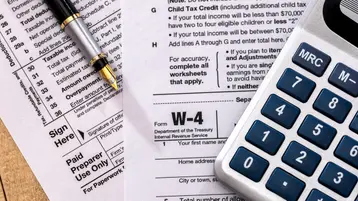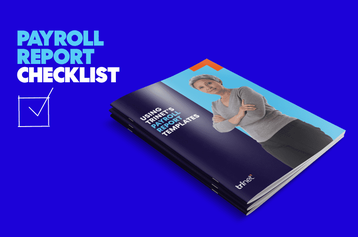
For many people, hiring forms are a mystery. However, it's important to understand your income tax obligations. Use the Internal Revenue Service (IRS) Form W-4 Employee's Withholding Certificate accurately. That way you are not caught off guard when you file your annual income taxes. You must complete Form W-4 Employee’s Withholding Certificate after being hired. A W-4 tells the employer your federal income tax filing status, plus additional information such as whether you have other W-4 deductions. You can also indicate if you want any additional amount withheld from each paycheck. In most states, there is also a state-based W-4 to complete. Enter your personal identifying information on the federal W-4 form, including your social security number. Also include information about income, dependents, and any additional adjustments. Employers must keep this form on file for at least four years after submitting an employee’s last tax return.
What is a W-4 and why do people fill it out?
The different income tax forms can be confusing, especially W-4 vs. W-9. There are 3 main forms for income tax reporting and recording: the W-4, the W-9, and the W-2. Employees complete the W-4 form so that employers know an individual’s tax filing status and how to process income tax withholdings. Non-employees compensated for anything outside permanent payrolls must complete a W-9 form. This can include independent contractors, vendors, and freelancers providing services. This form is for reporting how much is paid to non-payroll service providers so the IRS will know about non-employee compensation for tax purposes. Employers issue the W-2 form for each employee on their payroll. It is an annual account of the employee’s income, social security, and Medicare tax withholdings. The employee uses it for income tax filing purposes. W-2 forms must be distributed in January of each year for the prior year’s earnings.
What happens if you don't fill a W-4 out correctly?
The federal W-4 tax form is an IRS income tax filing form that individuals must provide to their employers upon hire and entry into a payroll system. It records the individual’s tax filing status. It also has deductions, any additional amounts to withhold, and other important information about income. If you don’t provide a completed Form W-4, your employer must withhold federal income taxes from your wages as single or married filing separately. That may not reflect your actual income tax obligation.
If you have too much withheld, you will have an overly large refund due to you. But if you have too little withheld, you will owe money to the IRS at tax time. This may incur an additional underpayment penalty. Filling out the Form W-4 accurately will help ensure the right amount is withheld from each paycheck. The W-4 tax form has fields in step 1 for your personal identifying information. Fill in your:
- Legal name
- Address
- Social security number
- Tax filing status
You must choose to file single, married filing separately, married filing jointly, qualifying widow(er), or head of household. You can stop after completing your personal information and sign and date the form. This lets the employer withhold at default levels. But it’s best to complete all the steps in the form that apply. This avoids surprises when it’s time to file your taxes.
Step-by-step guide
Account for all jobs you and your spouse may have on Step 2 on Form W-4. You’ll need to come as close as possible to your actual income. This information is on your most recent paycheck stubs, W-2 tax forms, and self-employment income records. There are 3 choices in Step 2, including an online estimator, an attached worksheet, or a check box to withhold at a default rate. The default rate option is most accurate if all jobs have similar or equal pay. Otherwise, you are better off either using the calculator or worksheet. Using the online estimator is a good option for single earners as it tells you the specific amount for the employer to withhold from each paycheck. The worksheet lets you figure out the correct withholding amount when there are multiple jobs for which you know the combined annual wages. Claim dependents in Step 3 on Form W-4. Be careful not to claim dependents on more than one job W-4 form. You may underpay and end up owing additional income taxes at year-end. Put other adjustments to your withholdings in Step 4. If you add other income or claim additional deductions, your withholdings will change accordingly. If you want your employer to withhold additional sums, you can add a dollar amount in the extra withholding field.
Best practices
You don’t have to fill out a new W-4 form every year, but it is a good idea to review your W-4 form at least annually if not every 6 months to make sure any changes in your circumstances are accurately reflected in your withholdings. For example, if you have a new baby, you should change your W-4 form by adding a dependent. If you take a second job or start earning freelance income in addition to your main job, you should review your W-4 to decide if you want to increase your withholdings for the extra income. If you have never filled out a W-4 form and are starting your first job, it’s worth the time to read through the form a couple of times. You can see a W-4 example on the www.irs.gov website. You can also review the IRS W-4 FAQs, or see a tax advisor for assistance and to ask questions. You can change your W-4 form at any time by completing a new form and turning it in to your employer.
This communication is for informational purposes only; it is not legal, tax or accounting advice; and is not an offer to sell, buy or procure insurance.
This post may contain hyperlinks to websites operated by parties other than TriNet. Such hyperlinks are provided for reference only. TriNet does not control such web sites and is not responsible for their content. Inclusion of such hyperlinks on TriNet.com does not necessarily imply any endorsement of the material on such websites or association with their operators.






